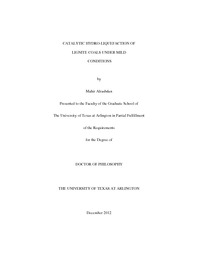| dc.description.abstract | A low-cost thermo-chemical process for the liquefaction of lignite coals is being developed at the University of Texas at Arlington (UTA). The coal-toliquids (CTL) project has focused of developing a liquefaction process which is made economically attractive by the combination of using a cheap coal feedstock, such as lignite, use of cheap disposable catalysts, and limiting the operating conditions to mild temperatures and pressures, at least relative to many existing CTL processes. The UTA-CTL process uses a solvent which is derived from the pyrolysis of lignite, an inexpensive iron-based catalyst and mild temperatures and pressures to hydrogenate and depolymerize the carbon structures found in lignite to produce a syn crude oil substitute. Our best process conditions give a syncrude product in 60 % liquid yield based on maf lignite. This yield translates to ~ 4.5 bbl syn oil/MT of moisture ash free (maf) lignite. Typical yields range between 35 - 55 % and a number of reaction parameters, including reaction time, temperature, pressure, catalyst loading, solvent, and initial coal moisture and ash content have been examined for their effect on the process. The nature of the catalyst has been varied within the constraints that the ultimate catalyst be very inexpensive and essentially, disposable after use. An economic analysis of the process suggests this process would be possible at larger scales at cost of $24 to 42 per bbl, which is very attractive given the current market price of crude oil is in the range of 85-105 $/bbl. The syn oil has been characterized by a number of tests obtained both locally and from external laboratories to evaluate its quality and value. UTA syn oil is found to have an average H/C ratio of 1.4 which is close to typical crude oil ranged between 1.5 to 1.9. The elemental and metal analysis of UTA syn oil shows in average the values of 83.0% Carbon, 10.0% Hydrogen, 1.0% Nitrogen, and low concentrations of Sulfur, Mercury and Iron. UTA syn oil was compared current liquid hydrocarbons and found to be with agreements with the current guidelines and limits as placed by the United States government. On the other hand, SARA analysis of UTA syn oil shows 18.0% wt of the contains as asphlaltenes, 17.5% wt as saturated hydrocarbons, 61.5% wt as aromatics, and 3.30% wt as resins. PNA analysis Shows 21.4% wt paraffins, 10.4% wt naphthalenes, and 68.2% aromatics. UTA syn oil average carbon number is 19 with wide distribution range between 9 to 40 C atoms. The simulated distillation of the UTA syn oil shows a recovery of 95.0% at 560 C and higher distillation temperature for UTA syn oil over the both kerosene and diesel. Given the relatively high aromatic content, this syn oil would likely be valued at a $10.00 discount relative to the benchmark premium crude oils, such as west Texas light sweet crude (WTI), which sell at the market price. | |

